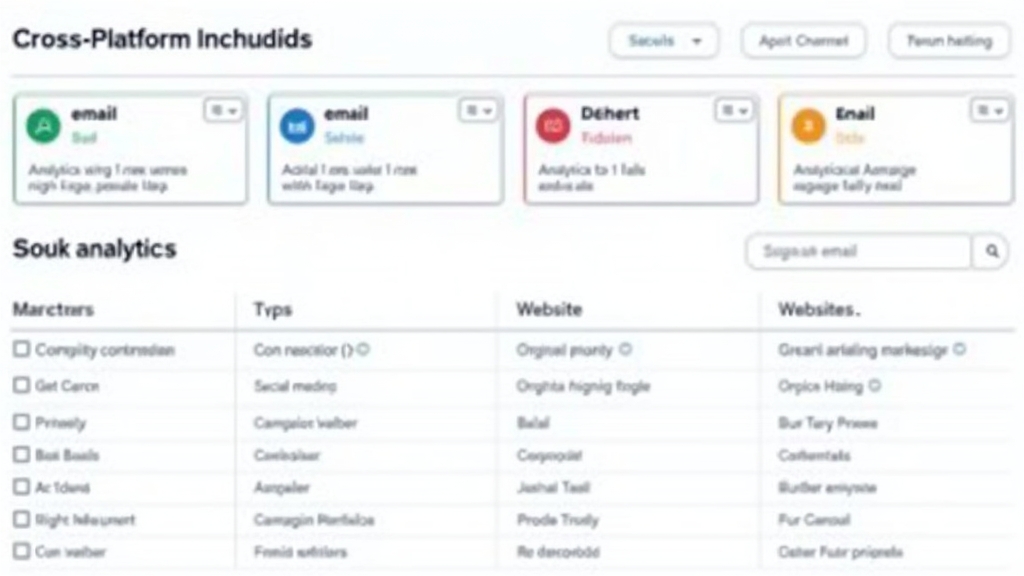Marketing: Cross-Platform Campaign Analytics Explained
Introduction
In today’s fast-paced digital world, understanding cross-platform campaign analytics is essential for any marketer. This approach allows you to track and analyze how your marketing efforts perform across various channels, such as social media, email, and websites. By utilizing cross-platform analytics, you can gain valuable insights into customer behavior and preferences. This knowledge helps you create more effective marketing strategies that resonate with your audience. As modern consumers engage with brands on multiple platforms, mastering this analytical technique is crucial for staying competitive.
Understanding Cross-Platform Campaigns
Definition and Scope
Cross-platform campaigns refer to marketing initiatives that span multiple channels or platforms simultaneously. These can include social media networks like Facebook and Instagram, email newsletters, websites, and even offline methods like print ads. The goal is to create a unified message that reaches your audience wherever they are most active.
Benefits of Cross-Platform Marketing
One significant benefit of cross-platform marketing is increased reach. By engaging customers on various platforms, you enhance brand visibility and recognition. Additionally, it allows for better targeting; different segments of your audience may prefer different channels. Finally, integrating data from these diverse sources provides a holistic view of customer interactions with your brand.
Key Components of Cross-Platform Campaign Analytics
Data Collection Methods
Effective data collection is the backbone of cross-platform campaign analytics. You can gather data through website tracking tools like Google Analytics or social media insights from platforms such as Facebook Insights or Twitter Analytics. Surveys and feedback forms also play a role in collecting qualitative data about customer experiences.
Metrics to Monitor
To gauge the success of your campaigns effectively, focus on key performance indicators (KPIs). Important metrics include engagement rates (likes, shares), conversion rates (how many users took action), click-through rates (CTR), and return on investment (ROI). Monitoring these metrics helps you understand what works best across different platforms.
Tools for Effective Analysis
Several tools can help streamline your analytics process. Platforms like HubSpot offer integrated solutions for tracking performance across various channels in one place. Other popular options include Hootsuite for social media management and Tableau for advanced data visualization.
Challenges in Cross-Platform Campaign Analytics
Data Integration Issues
One major challenge marketers face is integrating data from different sources into a cohesive format. Each platform has its own way of reporting metrics which can lead to inconsistencies when trying to analyze overall performance.
Measuring ROI Across Platforms
Calculating ROI accurately across multiple channels can be tricky due to varying costs associated with each platform’s advertising methods. It’s essential to establish clear benchmarks before launching campaigns so that comparisons remain valid throughout the analysis process.
Best Practices for Effective Cross-Platform Analytics
Consistent Branding Across Channels
Maintaining consistent branding ensures that customers recognize your brand no matter where they encounter it online or offline. Use similar visuals and messaging across all platforms while tailoring content slightly based on the specific audience of each channel.
Utilizing Advanced Analytics Tools
Investing in advanced analytics tools enables deeper insights into consumer behavior patterns over time rather than relying solely on basic metrics alone—this leads to more informed decision-making regarding future campaigns.
Regular Audits and Adjustments
Conducting regular audits helps identify areas needing improvement within existing strategies while allowing room for adjustments based on real-time feedback received during ongoing campaigns—this adaptability keeps efforts aligned with changing market dynamics!
Case Studies: Successful Cross-Platform Campaigns
Examples from Leading Brands
Many leading brands have successfully implemented cross-platform campaigns that showcase their effectiveness! For instance, Nike utilized an integrated approach by combining social media engagement with targeted email marketing during product launches—resulting in increased sales figures!
Lessons Learned from Each Case
From these successful examples comes valuable insight: consistency matters! Brands should ensure their messaging aligns seamlessly across all touchpoints while leveraging unique strengths inherent within individual platforms—this balance fosters stronger connections between businesses & consumers alike!
Future Trends in Cross-Platform Campaign Analytics
Emerging Technologies Impacting Marketing
As technology evolves rapidly today’s landscape continues transforming how we analyze our efforts! Artificial intelligence (AI) will likely play an increasingly prominent role by automating processes & providing predictive insights based upon historical trends observed over time!
Predictions for the Next 5 Years
Looking ahead five years down the line expect further integration between physical retail experiences & digital interactions—a seamless omnichannel experience will become standard practice among successful marketers striving toward enhanced consumer satisfaction levels!
Conclusion
In summary, mastering cross-platform campaign analytics is vital in today’s marketing landscape where consumer behaviors constantly evolve! By understanding its components—from effective data collection methods through measuring ROI—you’ll be well-equipped to adapt strategies accordingly while maximizing results moving forward!
📢 Explore More: Continue Your Journey!
If this article helped you understand cross-platform campaign analytics better, check out “The Power of Omnichannel Marketing”! It covers how integrating various marketing channels enhances customer experience effectively.














![NEEWER 55W 18"/45cm Ring Light Kit [New Version], 5600K Dimmable ...](https://m.media-amazon.com/images/I/414QLqvZWLL._AC_.jpg)








